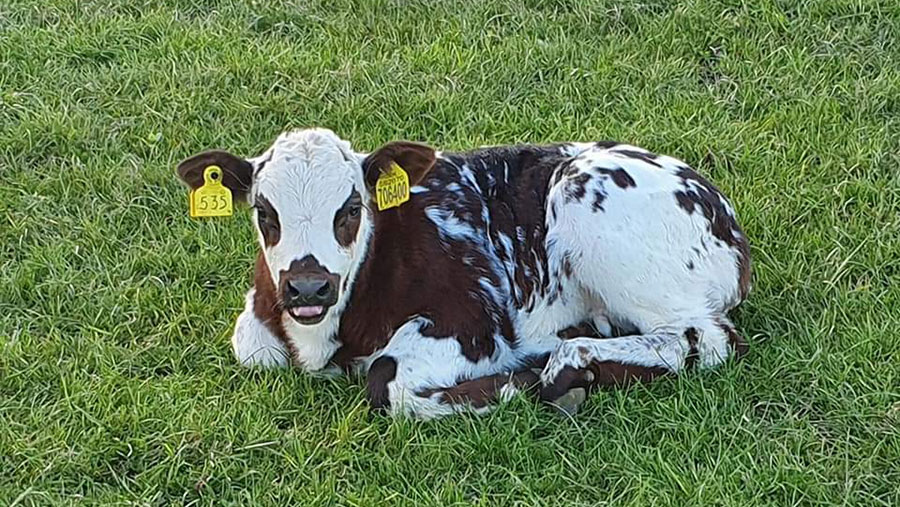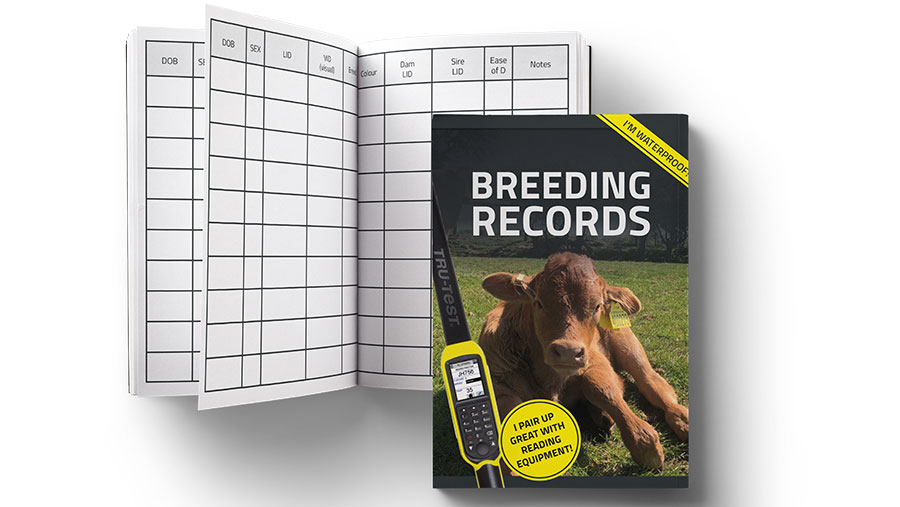Advertiser content
How to record and measure your spring calving performance
The recording and analysis of data as your herd calves may take some time, but it does enable the root causes of any production issues to be spotted quicker, more easily identified and then investigated quicker.
It can be a very valuable tool in the improvement of overall herd profitability.
In suckler herds the calf is the end product so monitoring health, growth, weaning or finishing weight plus the overall market desirability and final sale price reveal health and nutritional needs have been met and genetic traits influencing vigour, growth and £/kg all these combined factors, are providing a good return.
All this though starts from a successful calving, a hugely important event achieving not only a live birth but linking the calf to the dam and the sire.
Start simply with a handy record booklet perfect to fit in a top pocket to make physical notes.
DOB – recording all birth dates accurately reveals real herd fertility and aim to calve 65%+ in the first three weeks to maximise calf weight at weaning and ensure cows are cycling again in plenty of time for the bulls going back out.
SEX – generally speaking the wider the measure the closer to a 50:50 ratio but bull calves will finish heavier and larger birth weights may coincide with assisted/difficult calving so worth noting.
LID & VID – Tagging is mandatory so consider including an EID tag at little extra cost to utilise EID readers linked to weigher scales which offer digital record keeping opportunities and growth monitoring.
DAM LID & SIRE LID – link to their offspring so a real insight into genetic herd performance and improvements through correct sire choice and dam culling decisions which may not be immediately apparent at a herd level but revealed with individual performance unde +++r scrutiny.
Once again, a ‘third’ EID button tag can be incorporated into your data gathering activities and used when TB testing too.

Using EID stick readers in Offspring mode © Datamars Livestock
EASE OF D-recording the ease of the delivery also links the dam and sire, a large number of difficult births, caesareans or still births may indicate an unsuitable sire with oversized calves or even cows Body Condition Scores (BCS) indicate their nutritional path is incorrect and are too fat at calving.

Additional information with up to 10 fields on some devices © Datamars Livestock
Useful fields to complete in a calving record booklet
Calving record booklet KEY |
|
| DOB | The calves date of birth |
| SEX | The calves gender |
| LID | Lifetime identification number (official tag number) |
| VID | Visual identification number i.e. management number |
| DAM LID | Dams Lifetime identification number (official tag number) |
| SIRE LID | Sires Lifetime identification number (official tag number) |
| EASE OF D | Ease of delivery |
| NOTES | |
Each field in the calving record booklet pairs up perfectly with many of the Tru-Test readers and weigh scale indicators.
Empty cows who were presented to the bull and may be barren, have abortions or still births possibly indicating a BVD presence or other health issues. They need to be recorded and culled out.
Bull fertility may also be questioned if a large number of proven healthy cows are returning to heat and should not be culled out.
Consider Pregnancy Diagnosis (PD’ing) which identifies empty or barren cows culled out earlier long before their expected calving date and replacements brought in.
Saving feed and improving herd productivity.
Other aspects of herd health should be captured so as to allow retrospective analysis including incidences of lameness, milk fever, mastitis and any respiratory disease.
Ensure you are BVD free with a tag and test programme then preventative vaccination. BVD significantly affects herd fertility.
Calf health through to weaning or finishing
It is important to record those animals who do not make it to weaning, breeding or finishing.
Calf diseases such as scour and pneumonia should be recorded even if death does not occur as management intervention by improved housing facilities, cleanliness and vaccination etc. may offer prevention, reducing treatment costs and antibiotic reliance.
Where calves less than a month old are dying then this may suggest a colostrum issue, or poor hygiene if calving inside; where older calves are dying, then there are other issues to consider.
Another benefit that comes from collecting data on a farm is the potential to then benchmark your own herd’s performance by comparing it with the data from other similar farms, your own farm from previous years, or to recognised target figures of production.
Record keeping and data recording are therefore essential in maximising returns from your herd.
Tagging is a mandatory procedure from birth so incorporating EID tags which can be linked to digital weighing equipment offer great productivity insights and reveal and capture individual health, nutrition and genetic performance data.
Benchmarking is also a great management tool and is not as complicated as some may think -as long as you are collating data which can be compared with other similar herds, breeds and farm locations.
As well as setting some production targets to hit and improve on in subsequent years.
For those using AI which are predominantly in dairy herds, fertility benchmarking could suggest the herd has an underlying issue if a higher percentage of cows are returning to heat.
They may Infact have been served at the incorrect time. NADIS suggests this can be as high as 30%.
Reliable heat detection is another useful management tool to consider and several systems are available with Active Tag technology.
Newly calved cows and their calves need nurturing in readiness for better days ahead. Preparation, planning and key steps need to be in place long before any calves drop though to ensure healthy calves survive and thrive alongside their milky mothers with an eye on the next year breeding cycle too.
Spring calving considerations
- Getting cows in the right Body Condition Score (BCS) pre-calving
- Forage analysis so any supplementing can be planned
- Pre calving preparation can reduce calf mortality
- Vaccination pre and post calving and 3Qs of colostrum
- Handling, tagging weighing and recording data
Handling, tagging weighing and recording data
Tagging and in particular, including EID we have already discussed, many producers also find great productivity benefits from calf handling equipment for easier tagging and dehorning and not just using adult facilities or none at all.
Other equipment such as portable calf weigh platforms and digital scales also reap benefits.
- Regular weighing quickly reveals nutritional deficiencies and growing animals may not be receiving what they need, also health issues such as bovine respiratory diseases (BRD) which may go unnoticed can be treated quicker
- Maternal traits drive our output in calves born and reared. Fertility and easy calving are crucial for a productive herd. Any empty or barren cows need to be culled
- Daily Liveweight Gain (DLWG) through regular weighing of growing animals can also identify desirable genetic traits of thriving and faster finishing cattle
- Key decisions can be made so dairy heifers for example can be weaned and bulled at the correct weight which is crucial if they are to reach higher numbers of lactations and not be culled earlier
- Weaning efficiency of productive cows also increases herd output in terms of kg/Ha produced. With oversized suckler cows who thrive and consume are not always efficient and ideally calves should be close to 50% of their dams weight at weaning

© Datamars Livestock
Case Study
Kedzlie Farm Ltd in Lauderdale, Galashiels is a beef farm located in the heart of the Scottish Borders and have a large commercial suckler herd from which calves are sold as stores around 10-12 months.
They also run three highly acclaimed pedigree herds of Charolais, Limousin and Luing cattle from which bulls regularly top breeding sales.
Sally explains; “We have been using Roxan tags since they brought out the EID tag with the management spaces, in fact we trialled them for them and were very impressed with their readability and retention.”
For Sally , they have been a godsend. “The numbers on the tags are so clear and are easily seen from the front or from behind and with the management spaces we can give the pedigree calves their names without having to put a third tag in their ear”.
Kedzlie use the BVD tissue tags as the Primary tag so they don’t need to herd test every year to maintain their BVD accreditation.
“We currently have 520 cows due to calve in the spring so will be ordering our next batch of tags soon. Louise and Roxan overall, are excellent at dealing with our queries and requirements and the tags are always supplied within a few days. They are also very good when we need a tag (or 2) in a hurry too -an excellent service all round”.

© Datamars Livestock
Read our calving ebook and find out how to receive a free weatherproof calving record booklet.
Switch and upgrade
Time to upgrade?
No compromise on quality, choice, service or support when you switch and upgrade to any product lines from KiwiKit and Roxan.
Whether for tagging, EID reading, feeding or fencing, our products offer complete solutions for farmers to minimise cost and maximise output while ethically rearing productive and healthy livestock.
Visit www.roxan.co.uk
Provided by
KiwiKit bring New Zealand Solutions for British Farmers, Fencing Contractors and Veterinary Surgeons. Our aim is to provide good quality product that will do the job at the right price with a first class service to our customers. KiwiKit has a long history of bringing innovative products to the UK market and providing our customers with choice and quality with products that add value to your enterprise, or your lifestyle. ROXAN provide the world’s leading brands in livestock management systems from the fully automatic ear tagging system for sheep, TagFaster, to the accurate animal health delivery systems from Simcro and easy to use EID readers from Tru-Test.
